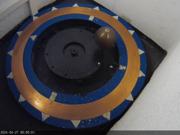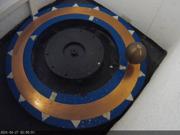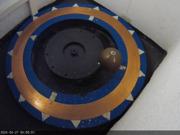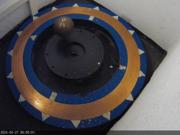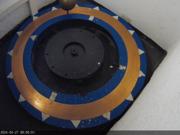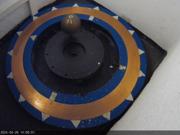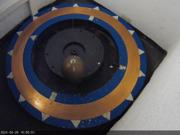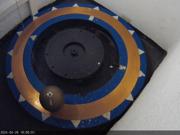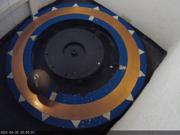Foucault pendulum
A Foucault pendulum, or Foucault's pendulum, named after the French physicist Léon Foucault, was conceived as an experiment to demonstrate the rotation of the Earth; its action is a result of the Coriolis effect. It is a tall pendulum free to oscillate in any vertical plane and ideally should include some sort of motor so that it can run continuously rather than have its motion damped by air resistance. The first Foucault pendulum exhibited to the public was in February 1851 in the Meridian Room of the Paris Observatory. A few weeks later, Foucault made his most famous pendulum when he suspended a 28-kg bob with a 67-metre wire from the dome of the Panthéon in Paris. In 1851 it was well known that the Earth moved: experimental evidence included the aberration of starlight, stellar parallax, and the Earth's measured polar flattening and equatorial bulge. However Foucault's pendulum was the first dynamical proof of the rotation in an easy-to-see experiment, and it created a justified sensation in both the learned and everyday worlds.
At either the North Pole or South Pole, the plane of oscillation of a pendulum remains pointing in the same direction while the Earth rotates underneath it, taking one sidereal day to complete a rotation. When a Foucault pendulum is suspended somewhere on the equator, then the plane of oscillation of the Foucault pendulum is at all times co-rotating with the rotation of the Earth.
What happens at other latitudes is a combination of these two effects. At the equator the equilibrium position of the pendulum is in a direction that is perpendicular to the Earth's axis of rotation. Because of that, the plane of oscillation is co-rotating with the Earth.
Away from the equator the co-rotating with the Earth is diminished. Between the poles and the equator the plane of oscillation is rotating both with respect to the stars and with respect to the Earth. The direction of the plane of oscillation of a pendulum with respect to the Earth rotates with an angular speed proportional to the sine of its latitude; thus one at 45° rotates once every 1.4 days and one at 30° every 2 days.
Many people found the sine factor difficult to understand, which prompted Foucault to conceive the gyroscope in 1852. The gyroscope's spinning rotor tracks the stars directly. Its axis of rotation turns once per day whatever the latitude, unaffected by any sine factor.
A Foucault pendulum is tricky to set up because imprecise construction can cause additional veering which masks the terrestrial effect. Air resistance damps the oscillation, so Foucault pendulums in museums usually incorporate an electromagnetic or other drive to keep the bob swinging.
The Foucault pendulum that hangs in the rotunda of the Lexington Public Library in Lexington, Kentucky in the United States is the largest ceiling clock in the world.
This article is licensed under the GNU Free Documentation License. It uses material from the Wikipedia article "Foucault pendulum".

